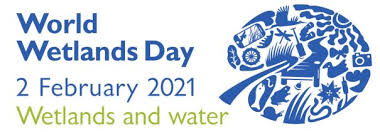 World Wetlands Day
World Wetlands Day
February 2, 2021
Theme: Wetlands and Water
Water is life, and wetlands are the life support systems that ensure functioning of water cycle. India is endowed by a rich diversity of wetlands ranging from high altitude wetlands of Himalayas, floodplains of mighty rivers as Ganges and Brahmaputra, lagoons and mangrove marshes on the coastline and reefs in the marine environments. As per National Wetland Atlas, nearly 4.7% of India’s geographical area is under wetlands.
Wetlands are vital for our water and food security. As ‘kidneys of landscape’, wetlands receive flows of water and waste from upstream sources. They help stabilize water supplies, cleanse polluted waters, protect shorelines, and recharge groundwater aquifers. The extensive food chain and biological diversity in wetlands make them ‘biological supermarkets’. Wetlands are valuable as sources, sink and transformers of a multitude of biological, chemical and genetic material. In addition, wetlands have special attributes as cultural heritage of humanity, and have deep connections with our beliefs and practices. They are indeed an important part of our natural wealth and “liquid assets”.
The Convention on Wetlands, called the Ramsar Convention, is an intergovernmental treaty that provides the framework for national action and international cooperation for the conservation and wise use of wetlands and their resources. The Convention was adopted in 1971 at the Iranian City of Ramsar. Contracting Parties to the Convention commit to designating wetlands into the List of Wetlands of International Importance (as per 8 criteria set by the Convention), and wise use of all wetlands in their territory. As on date, the Convention has 170 Contracting Parties, who have designated 2,339 Ramsar Sites covering an area more than 252 million hectare, making it one of the world’s largest protected area network. India became a party to the Convention in 1982, and as on date has designated 26 wetlands as Ramsar Sites under the 9 designation criteria of the Convention.
The ‘wise use’ approach of Ramsar Convention is globally recognized. Notably, the wise use approach was coined in 1972, much before the hallmark 1992 Rio Conference wherein the term sustainable development was rendered a definition. As endorsed by Contracting Parties of the Ramsar Convention, wise use of wetlands is “the maintenance of their ecological character, achieved through the implementation of ecosystem approaches, within the context of sustainable development”. The wise use approach recognizes that stemming wetland loss and degradation requires incorporation of linkages between people and wetlands, and thereby emphasizes that human use of these ecosystems on sustainable basis is compatible with conservation.
2nd February of each year is celebrated as World Wetlands Day to mark the date of adoption of Ramsar Convention on Wetlands. The Convention is the only multilateral environmental agreement to date for conservation and wise use of wetlands. The year 2021 marks the 50th year of the signing of the Convention. World Wetland Day is being organized to raise awareness on the values wetlands have for nature and society. Each year, the World Wetlands Day is attached to a specific theme.
The theme of WWD-2021 is “Wetlands and Water” which draws attention to the fact that
· only 2.5 % of water on the earth is fresh water
· of which less than 1% is usable.
· Our water use has increased sixfold in 100 years and rises by 1% each year.
· Almost 2.2 billon people do not have access to safe drinking water.
· Clean water is critical for healthy lives.
Humans are destroying wetlands. Wetlands are vanishing three times faster than forests. 35% of wetlands have disappeared since the 1970s. 87% have been lost since the 1700s. Causes of wetland loss are drainage and infilling for agriculture and construction, pollution, overexploitation of resources (e.g., overfishing), invasive species and climate change.
The Ministry of Environment, Forest and Climate Change, as the nodal Ministry for wetlands conservation have been assisting State Governments since 1985 in design and implementation of integrated management plans. In 2017, the Ministry has also notified the Wetlands (Conservation and Management) Rules as the regulatory framework for wetlands in the country. Several states have also notified wetland authorities and acts and rules for conservation and wise-use of wetlands. Guidelines for implementation of the Rules were also released last year.
The following actions are recommended for spreading the message of conservation of wetlands:
- Restore, conserve and promote wise use of all wetlands
- Don’t drain
- Don’t build over
- Don’t degrade
- Assess the real value of wetlands
- Organize an event to raise awareness about the importance of role of wetlands in providing freshwater
- Learn about the types of wetlands in your country
- Assess the real value of wetlands. Use a diagnostic approach to identify root causes of wetlands degradation, and ensure that the management plan is adequate to respond to the risks.
- Monitor wetland ecosystem health periodically.
- Disseminate information on Wetlands and freshwater to all stakeholders